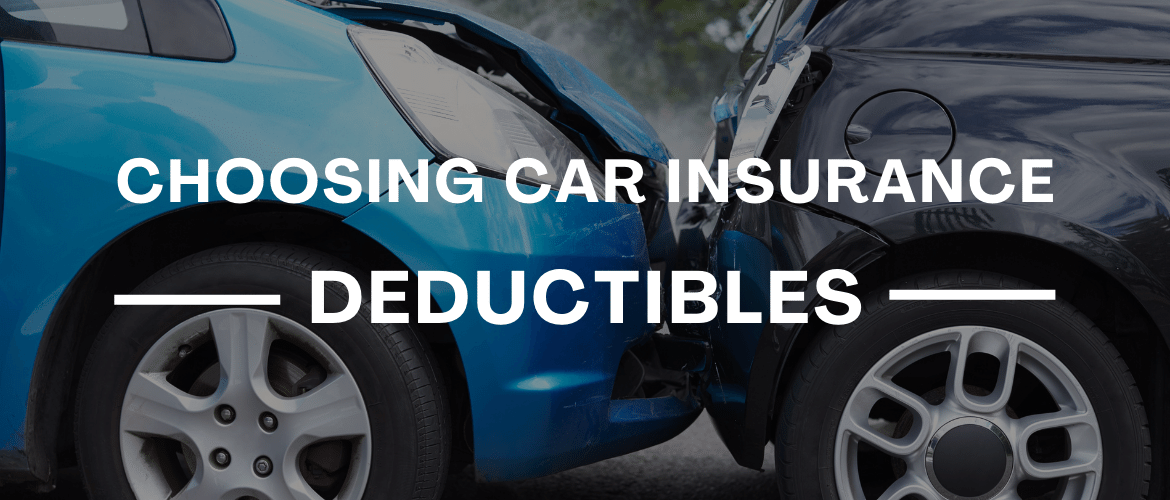
Choosing your car insurance deductible is not always easy. When comparing different auto coverages, however, it is important to consider the different car deductible amounts and options in order to make an informed decision.
A policy with a high deductible on car insurance can have different financial consequences to a policy that has a lower deductible.
Continue reading to find out more about car insurance deductibles and how you can choose the right amount for you.
What is a car insurance deductible?
Let’s start with the basics. What is a car insurance policy deductible and how does it work?
The deductible is the amount that you pay out-of-pocket before your insurer starts paying for repairs. Each time you file a claim, you will be required to pay the deductible.
If you have a $3,000 car repair and a $1,000 deductible on your insurance, you’d be responsible for $1,000. The insurance company would then pay the remaining $2,000. If the repair cost is less than the deductible you will be responsible for the entire cost of repair.
Some types of insurance do not have a deductible. In general, deductibles apply to collision, comprehensive, uninsured/underinsured motorist, and personal injury protection.
The deductible for auto insurance can be as low as $100 to as high at $2,500. The most common option is $500. It doesn’t matter how much you choose as long as you can afford to pay it if you have to file a claim.
What does a car insurance deductible do?
When you purchase your policy, you can choose your deductible. If you file a claim, policies with lower deductibles will have higher premiums and lower out-of-pocket costs. Policies with higher deductibles will have higher premiums, but lower out-of-pocket expenses if you file for a claim.
The deductible is the amount you pay when you file a claim with your insurance broker. If the deductible exceeds the amount, the carrier will cover it.
How does a car insurance deductible work?
Imagine that a tree branch falls on to your car, causing damage. You file a claim under your comprehensive coverage. The repair shop estimates that it will cost $1,000. Your deductible will determine how much you pay.
| If your deductible is… | You pay | Insurance pays |
| $250 | $250 | $750 |
| $500 | $500 | $500 |
| $1,000 | $1,000 | $0 |
You may decide not to file a claim if the repair cost is equal or near your deductible since this may result in you losing any discount you may have.
The deductible is your responsibility.
When do you have to pay the car insurance deductible?
After the repair is completed, you will typically pay your deductible directly at the auto shop. Your deductible will be deducted from the amount sent to the shop by your insurer. In the example of a $1000 repair with a $500 deductible, you would be expected to pay the $500 car insurance deductible and the insurer would pay the $500 balance directly to the auto shop.
 6 Steps for choosing a car insurance deductible
6 Steps for choosing a car insurance deductible
These six steps will help you determine the best car insurance deductible for your needs.
1. You can choose between a high or low deductible
It is easy to see a direct relationship between your insurance rate and your deductible. Lower deductibles are associated with higher monthly premiums. If you file a claim, however, you will pay more out of pocket if your deductible is higher.
| Low DeductibleIt is better to avoid large bills after filing a claim. However, your monthly rates will be higher. | High DeductibleIt’s better to have lower monthly costs. However, if you file a claim, you will pay more out-of-pocket. |
2. Calculate the cost difference
It is worth comparing auto policies by looking at the price difference between plans with high deductibles and those with low deductibles. Your total cost will depend on whether you file claims. It’s worth running a few calculations to compare your out-of-pocket expenses, whether you file one, two, or all three claims.
The driver would save $1116 annually if they had high-deductible insurance and did not file any claims. However, if the driver had to file two claims in one year, a low deductible policy would help them save $384 on out-of-pocket expenses.
| Low Deductible$250 deductible plan starting at $182 per Month
Annual Cost With No Claims $2.184 Annual Cost With 1 Claim:$2,434 Annual Cost With 2 Claims:$2,684 |
High Deductible$1,000 deductible plan $89 per Month
Annual Cost With No Claims: $1.068 Annual Cost With 1 Claim:$2,068 Annual Cost With 2 Claims:$3,068 |
3. Do you think you might have to file a claim?
A low-deductible car insurance plan will generally be a better choice for drivers who are more likely to file an insurance claim. Drivers who do not file a claim will save money by choosing a plan with a higher-deductible. When you choose a high car insurance deductible, you are basically betting on not having to file a claim.
Do you have a history of car accidents? Are your driving habits high-risk such as speeding, rush-hour driving? These are just a couple of questions to ask yourself when making a decision.
| Low DeductibleBetter if you’re more likely to have a car accident | High DeductibleBetter if you’re less likely to have a car accident |
4. What is your car’s value?
Depending on your location, insurance companies will only pay up to the actual value for your vehicle if it is declared a total loss. If your car isn’t worth much, it’s probably better to have a lower deductible.
Let’s take, for example, that your vehicle is worth $1,500, and that you have a $1,000 deductible on your insurance policy. After you have paid the deductible, your vehicle will be totaled and the insurer will pay only $500.
The flip side is that if your car is worth $10,000 and you have $1,000 deductible, insurance companies will pay $9,000. In this case, a higher deductible could make sense.
Calculate the car’s value and then compare it to your insurance costs. Remember that you don’t need to select the same deductible for all types of coverage. An agent from your insurance company may be able to help you mix and match deductible amounts depending on the value of your vehicle and the risks that you are taking.
| Low DeductibleBetter for cheaper cars | High DeductibleBetter for more expensive cars |
5. Assess Your Cash Savings
You will need to pay your deductible if you are involved in a car accident before your insurance company begins paying for the repairs.
A low-deductible policy is a better option if you don’t have enough savings or an emergency fund. If you are in an accident, paying higher insurance premiums each month may be a better option to protect your finances.
| Low DeductibleBetter for those who don’t want to be surprised by a large bill after an accident. | High DeductibleBetter if you have enough savings to pay the deductible after an incident |
6. What is your tolerance for risk?
You are taking a risk by choosing a high-deductible policy. You are still covered if you have an accident regardless of what your deductible is. However, you will pay more for the accident than if your policy had a lower deductible.
| Low DeductibleBetter for risk-averse people | High DeductibleBetter for those who feel comfortable taking the chance of not needing to file a claim |
Car insurance deductible comparison summary
High deductible car insurance is good for those:
- Less likely to be in a car accident, or file a claim
- Who have an emergency fund in case of a major repair bill
- Insuring a more expensive car.
- More comfortable with risk
Low deductible car insurance is better for those:
- More likely to file an insurance claim
- With a lower-value vehicle
- Who do not have enough money to pay for a large bill
- Risk-averse
 FAQ about car insurance deductibles
FAQ about car insurance deductibles
What does it mean if you have a $1,000 deductible?
A $1,000 deductible will mean that you will only pay the first $1,000 on any comprehensive or collision claim you file. On a $2500 repair, your insurance company will cover $1500, and you will be responsible for the other $1,000. You may also have deductibles for other coverages such as personal injury protection or uninsured motorist.
Do you pay the deductible amount to your insurance company?
NO, your insurance company will subtract your deductible from your covered amount after a claim is approved. If your car requires $2,000 repairs and you have a $500 deductible, your insurance company will pay $1,500 to you or your repair shop. You would pay the repair shop $500 remainder. If you have an insured vehicle worth $10,000 and it is totaled and you have a $500 deductible, your insurance company will pay you $9,500.
What if I hit someone with my car?
You will have to pay a deductible if your car is damaged by the accident (collision insurance). While your liability insurance covers injuries and property damage for the other person automatically, it does not require a deductible. However, your car insurance rates will increase. You might need to pay a higher deductible if you have personal injury protection. This depends on the state you live in.
Is a higher car insurance deductible better?
Your monthly premiums will be lower if your deductible is higher for car insurance. However, you will have to pay more if you need it. Your auto insurance coverage will be the same regardless of whether you have a $100 deductible or a $1,000 deductible. The only difference is your monthly bill and the out-of-pocket costs after an accident. A higher deductible will lower your premium while a lower deductible will increase your premium. Call your local insurance agency to get an estimate today.

